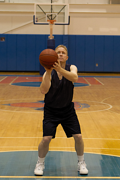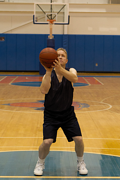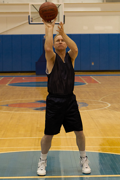FREE THROW SHOOTING
By Hal Wissel
Mechanics
The mechanics of free-throw shooting include balance, sight, hand position, elbow-in alignment, rhythmical shooting motion and follow-through.
 |
 |
 |
| Shooting Hand High and Front | Down and Up Rhythm | As Knees Go Up Arm Goes Up |
Balance. Spread your feet comfortably to shoulder width with your toes straight and knees slightly flexed.
Sight. Focus your eyes on the basket, aiming just over the front of the rim.
Hand Position. Hand position is the most misunderstood part of shooting. Start with you shooting hand set high (between your ear and shoulder) and facing the front of the basket with your index finger at the ball’s midpoint. Your non-shooting (balance) hand should be slightly under the ball. The ball balances on at least two fingers: the ring and the little finger. This leaves your shooting hand free to shoot the ball, rather than having to balance and shoot the ball. A relaxed hand position (like a handshake) forms a natural cup, enabling the ball to be released off the pads of your index finger and not your palm. This leads to a soft touch and your shooting hand going straight.
Elbow-In Alignment. Keeping your shooting elbow in, aligns the ball with the basket. Some players do not have the flexibility to place the shooting hand facing the basket while keeping the elbow in. In this case, the shooting hand facing front takes preference over the elbow in. First place the shooting hand facing the basket, then move the elbow in as far as your flexibility allows.
Rhythmical Shooting Motion. Shoot the ball with a smooth, evenly paced, rhythmical lifting motion. Rhythm and range come from the down-and-up motion of your legs. Your legs and shooting arm work together. As your legs go up, your arm goes up. As your legs reach full extension, your back, shoulders, and shooting arm extend in a smooth, continuous upward direction. Use the down-and-up motion of your legs for rhythm rather than lowering the ball for rhythm. Keeping the ball high provides less chance for error. The final force and control of your shot comes from flexing your wrist and fingers forward toward the basket.
Follow-Through. Direct your arm, wrist, and fingers straight toward the basket at a 45- to 60-degree angle, extending your shooting arm completely at the elbow. Keep your balance hand on the ball until the point of release. Hold your arm up in a complete follow-through position until the ball reaches the basket. Keeping your follow-through up is not only good mechanics, but it also makes you look and act like a shooter and increases confidence.
Mental Aspects
Successful free throw shooting includes two Cs: confidence and concentration; and three Rs: routine, relaxation and rhythm. Routine, relaxation, and rhythm contribute to your concentration and confidence.
Confidence. Think positively. You always shoot from the same place on the line. No one is guarding you. The basket is big. Over three and one-half balls can fit in the rim. With confidence – and sound mechan¬ics – you cannot miss. Act like a shooter. Using affirmation statements can promote con¬fident thoughts about yourself and your ability to shoot. For example, you can state to yourself, “I am a shooter,” or remind yourself of past successes. Exag¬gerate your follow-through by keeping your eyes on the target and your shooting arm up until the ball reaches the basket. Act like a shooter!
Routine. Developing a sound routine before shooting a free throw will enhance your confidence. A sound routine also helps you relax, focus, and shoot with rhythm. Your routine should start with you standing a few feet behind the free throw line until the official hands you the ball. You will stay more relaxed there. Once you receive the ball, position your feet, making certain to line up the ball (not your head) with the middle of the basket. Use the small inden¬tation mark in the floor at the exact middle of the free throw line that marks the free throw circle. Set your shooting side foot slightly outside this mark, lining up the ball with the middle of the basket. Set up in a balanced stance. Some players bounce the ball a certain number of times to help them relax. When you bounce the ball, keep your shooting hand on top. This helps you to have your shooting hand facing the basket when you set the ¬¬ball high in position to shoot. Use a relaxed hand position, and line up your index finger with the valve on the ball or the seam below the valve with your shooting hand facing the rim.
Visualize a successful free throw. Mentally practice a successful free throw just before you shoot. This can help you produce a more free-flowing, smooth rhythm and increase confidence. .Some players like NBA stars Steve Nash and Ray Allen (both ninety percent free throw shooters) physically simulate the motion of a free throw before shooting. Adopt a sound routine and stay with it; it is a mistake to copy fads or repeatedly change your routine.
Relaxation. Learn to relax before shooting a free throw. You have more time to think before shooting a free throw than with other shots. Trying too hard may cause undue physical or emotional tension. Use deep breath¬ing to relax your mind and body. For a free throw, you should particularly relax your shoulders; take a deep breath and let your shoulders drop and loosen. You can also relax other parts of your body such as arms, hands, and fingers. Controlling your breathing and relaxing your muscles are especially useful in a free throw routine. If you hear negative remarks from the crowd or recognize your own negative thoughts, interrupt them with the word “Stop!” Take a deep breath and eliminate any negative thoughts as you exhale. Replace negative thoughts with a positive affirmation statement such as “I’m a shooter!” “Nothing but net!” or “Count it!”
Concentration. Just before shooting, focus on your target just over the front of the rim. Keep your focus on the target as you shoot and hold your follow-through until the ball goes through the net. Confidence and concentration go together. Act like a shooter.
Rhythm. Start your shot high and use the down-and-up motion of your legs for rhythm rather than lowering the ball for rhythm. The down-and-up motion of your legs provides momentum for your shot and is particularly helpful when shooting late in the game when your legs are tired. By starting the ball high and using your legs for rhythm, you will lessen the chance for error that can come with lowering the ball. Exaggerate your follow-through, keeping your eyes on the target and your shooting arm up until the ball reaches the basket.
Shoot the free throw with a smooth, free-flow¬ing rhythm. Use your own personalized key words (also called cue or trigger words) and an anchor word (confident word). This helps establish a smooth, sequential rhythm for free throw shooting. For example, if your trigger words are legs and through and your anchor word is yes, say them together “Legs-through-yes!” in the rhythm of your shot, from the start of your shot until release of the ball. Using personalized key words this way establishes your rhythm, enhances your mechanics, and builds confidence.
Error: You feel tense before and during your free throw.
Correction: Use deep breathing to relax your mind and body. Breathe in deeply and exhale fully. Relax your shoulders, letting them drop and loosen. Do the same for your arms, hands, and fingers. Learn to relax other parts of your body as necessary.
Free Throw Shooting
Edited from: Wissel, H. (2011). BASKETBALL: Steps to Success. Third Edition. Human Kinetics, Champaign, IL.
Wissel, Hal. (2009). Basketball Shooting: Make Your Shot Automatic DVD. Basketball World, Suffield, CT. Wissel, Hal. (2005). Basketball Shooting: Confidence, Rhythm and Mechanics DVD. Basketball World, Suffield, CT.
Dr. Hal Wissel conducts SHOOT IT BETTER Mini Camps worldwide and year round for players ranging from NBA and WNBA to youth level. Visit: http://www.basketballworld.com or call BASKETBALL WORLD at 888-812-5452 or 860-668-7162
